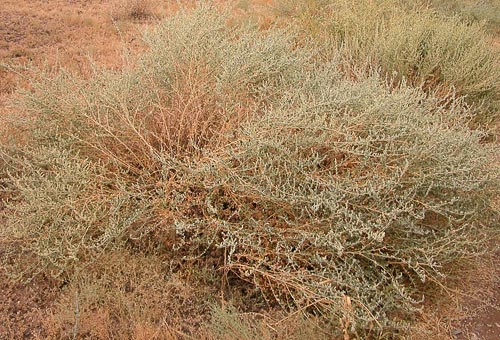Relatives
Kochia prostrata (L.) Schrad. - Prostrate summer cypress.
Taxonomic position.
Family Chenopodiaceae Vent.Synonyms.
Salsola prostrata L., Chenopodium angustatum All. Forage kochia, izen, prutnyak.Biology and morphology.
Perennial xerophyte. Half shrub with autumn type of growth, up to 30-120 cm tall with ascending stems. Stems grow from a low, woody base. The upper stems turn reddish brown and dry up after seed shatter. The lower stems stay green and succulent year-round. Plant, pubescent, develops an extensive fibrous root system with a tap root that may extend to a depth of 10 m or more. Leaves alternate, usually clustered on dwarf, axillary branchlets, sessile. Leaflets 0.6-1.5 cm in length, 0.05-0.28 cm in width, lanceolate or linear. Flowers in interrupted clusters. Flowers have appendages that are round, flat, or wing-like. Seeds oval or round. Fruit is a utricle, with 5 small wings of approx. 2 mm in diameter. Seeds ripen in late October and November. Seeds ripen unevenly, even on the same raceme. Freezing temperatures hasten seed ripening. Seeds germinate well for up to 6-8 months after harvest. Wind-pollinated plant. Kochia prostrata is a very variable species. Several intraspecific taxa have been described, differing mostly in pubescence and some other minor characteristics, probably related to environmental factors, but partly also dependent on geographic and karyological races. 2n=18, 36, 54.Distribution.
Occurs throughout Central Asia, Crimea, Southern Russia, Ukraine and Moldavia.Ecology.
Grows in dry steppe, semi-desert and desert areas (up to 3,800 m above sea level). Occurs on sands, solonetz soils and solonchak. Most common in alkaline clay soils. It is well-adapted to a wider range of soils, including fine- to coarse-textured, shallow- to deep-gravelly to stony, and saline to alkaline. It seems to grow best on heavily textured soils. It is not well-adapted to neutral or acidic soils.Utilization and economic value.
Promising arid forage plant. Characterized by nutritious properties and stable harvests. Long-vegetating plant (200-300 days in Kazakhstan), which can be utilized as year-round grazing pasture forage. Useful as perennial component for long-term artificial pasture establishment in extremely arid conditions.Literature cited:
Brezhnev D.D., Korovina O.N. 1980. Wild relatives of the cultivated plants of flora of the USSR. L.: Kolos, 376 pp. (in Russian).Goloskokov V.P. 1960. Genus Kochia. Flora of Kazakhstan. Vol. 3. Alma Ata: AN KazSSR. pp. 230-236. (in Russian).
Iljin M.M., ed. 1936. Flora of the USSR. Vol. 6. M.-L.: USSR, 956 pp. (in Russian).
Ivanov A.I., Soskov U.D., Bukhteeva A.V. 1986. Resources of perennial fodder crops in Kazakhstan. Alma Ata: Kainar, 219 pp. (in Russian).
Kurochkina L.Ya., Osmanova L.T., Karibaeva K. N. 1986. Forage plants of Kazakhstan.s deserts. Alma Ata: Kaynar, 207 pp. (in Russian).
Medvedev P.F., Smetannikova A.I. 1981. The forage crops of the European part of the USSR. L.: Kolos, 336 pp. (in Russian).
Musaev I.F. 1965. The northern borders of distribution of typical components of Turan desert flora. In book: Areas of plants of flora USSR. L.: Leningrad University Publisher, p. 93-139. (in Russian).
Nikitin V.V., Geldikhanov A.M. 1988. Plants of Turkmenistan. A field guide. L.: Nauka, 680 pp. (in Russian).
Ovchinnikov P.N., ed. 1978. Flora of Tajikistan. Vol. 3. L.: Nauka, 711 pp. (in Russian).
Sergievskaja L.P. 1964. Genus Kochia. Flora of Western Siberia. Vol. 12, part 2. Tomsk: Nauka, p. 3260-3261 (in Russian).
Tzvelev N.N., ed. 1996. Flora of East Europe. St. Petersburg: Mir i Semja-95, 451 pp. (in Russian).


